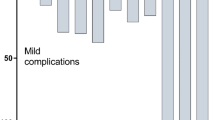Abstract
Background
The model for end-stage liver disease (MELD) is useful for assessing the recipients of liver transplants, namely, deceased-donor transplantation. The application of MELD for living donor liver transplantation (LDLT) is under investigation. Thus, the aim of this study was to analyze the impact of the MELD score in LDLT in Japan.
Methods
Seventeen adult cases of LDLT during 2001 to 2005 were enrolled. Indications for LDLT were primary biliary cirrhosis, seven; liver cirrhosis, two; hepatocellular carcinoma (HCC), three; metabolic liver disease, one; primary sclerosing cholangitis, two; Caroli's disease, one; and biliary atresia, one. Total medical charges during the operative periods were retrospectively evaluated. The united network of organ sharing (UNOS) modified was obtained using preoperative clinical data.
Results
The average medical expense of the 17 cases was approximately $97 901. The UNOS-modified MELD score was 22.1. A statistically significant positive correlation was found between the MELD score and medical expense (P = 0.0086, ρ = 0.657), and between the MELD score and the length of stay in the intensive care unit (ICU) (P = 0.0396, ρ = 0.515). The cause of the liver disease leading to transplantation was not related to MELD score, medical expense, or length of ICU stay.
Conclusions
Although not originally designed for the application to LDLT, the MELD score is useful for predicting medical expenses in LDLT. Similar to those of deceased-donor liver transplantation, the disadvantage of high medical expenses associated with a high MELD score allow consideration of an earlier elective operation in suitable cases.
Similar content being viewed by others
References
WR Kim RS Brown NA Terrault H El-Serag (2002) ArticleTitleBurden of liver disease in the United States: summary of a workshop Hepatology 36 227–42 Occurrence Handle12085369 Occurrence Handle10.1053/jhep.2002.34734
K Tanikawa (1992) ArticleTitleIndication of liver transplantation for hepatocellular carcinoma in Japan Surg Today 22 395–400 Occurrence Handle1330113 Occurrence Handle10.1007/BF00308786 Occurrence Handle1:STN:280:ByyD2czpsF0%3D
M Malinchoc PS Kamath FD Gordon CJ Peine J Rank PCJ ter Borg (2000) ArticleTitleA model to predict poor survival in patients undergoing transjugular intrahepatic portosystemic shunts Hepatology 31 864–71 Occurrence Handle10733541 Occurrence Handle10.1053/he.2000.5852 Occurrence Handle1:STN:280:DC%2BD3c7pvVWmtA%3D%3D
R Wiesner E Edwards R Freeman A Harper R Kim P Kamath et al. (2003) ArticleTitleModel for end-stage liver disease (MELD) and allocation of donor livers Gastroenterology 124 91–6 Occurrence Handle12512033 Occurrence Handle10.1053/gast.2003.50016
RH Wiesner (2004) ArticleTitleMELD/PELD and the allocation of deceased donor livers for status 1 recipients with acute fulminant hepatic failure, primary nonfunction, hepatic artery thrombosis, and acute Wilson's disease Liver Transpl 10 S17–22 Occurrence Handle15382286 Occurrence Handle10.1002/lt.20273
RH Wiesner SV McDiarmid PS Kamath EB Edwards M Malinchoc WK Kremers et al. (2001) ArticleTitleMELD and PELD: application of survival models to liver allocation Liver Transpl 7 567–80 Occurrence Handle11460223 Occurrence Handle10.1053/jlts.2001.25879 Occurrence Handle1:STN:280:DC%2BD3MvhtFyntA%3D%3D
PS Kamath RH Wiesner M Malinchoc W Kremers TM Therneau CL Kosberg et al. (2001) ArticleTitleA model to predict survival in patients with end-stage liver disease Hepatology 33 464–70 Occurrence Handle11172350 Occurrence Handle10.1053/jhep.2001.22172 Occurrence Handle1:STN:280:DC%2BD3M7kvVOqug%3D%3D
WK Kremers M van IJperen WR Kim RB Freeman AM Harper PS Kamath et al. (2004) ArticleTitleMELD score as a predictor of pretransplant and posttransplant survival in OPTN/UNOS Status 1 patients Hepatology 39 764–9 Occurrence Handle14999695 Occurrence Handle10.1002/hep.20083
HY Yoo PJ Thuluvath (2005) ArticleTitleShort-term postliver transplant survival after the introduction of MELD scores for organ allocation in the United States Liver Int 25 536–41 Occurrence Handle15910490 Occurrence Handle10.1111/j.1478-3231.2005.01011.x
Jr RB Freeman RH Wiesner A Harper SV McDiarmid J Lake E Edwards et al. (2002) ArticleTitleThe new liver allocation system: moving toward evidence-based transplantation policy Liver Transpl 8 851–8 Occurrence Handle12200791 Occurrence Handle10.1053/jlts.2002.35927
DA Axelrod AJ Koffron T Baker P Al-Saden I Dixler G McNatt et al. (2005) ArticleTitleThe economic impact of MELD on liver transplant centers Am J Transplant 5 2297–301 Occurrence Handle16095512 Occurrence Handle10.1111/j.1600-6143.2005.01025.x
M Jacob LP Copley JD Lewsey A Gimson GJ Toogood M Rela et al. (2004) ArticleTitlePretransplant MELD score and post liver transplantation survival in the UK and Ireland Liver Transpl 10 903–7 Occurrence Handle15237375 Occurrence Handle10.1002/lt.20169
R Zapata F Innocenti E Sanhueza R Humeres H Rios L Suarez et al. (2004) ArticleTitlePredictive models in cirrhosis: correlation with the final results and costs of liver transplantation in Chile Transplant Proc 36 1671–2 Occurrence Handle15350447 Occurrence Handle10.1016/j.transproceed.2004.06.071 Occurrence Handle1:STN:280:DC%2BD2cvksVersw%3D%3D
K Tanaka T Yamada (2005) ArticleTitleLiving donor liver transplantation in Japan and Kyoto University: what can we learn? J Hepatol 42 25–8 Occurrence Handle15629503 Occurrence Handle10.1016/j.jhep.2004.11.004
S Todo H Furukawa (2004) ArticleTitleLiving donor liver transplantation for adult patients with hepatocellular carcinoma: experience in Japan Ann Surg 240 451–9 Occurrence Handle15319716
E Mikami N Kanno Y Ueno T Shimosegawa (2004) ArticleTitleRetrospective evaluation of tumor-mass reduction therapy for hepatocellular carcinoma: is it effective for improvement of prognosis? Hepatology 40 303A
Mazzaferro V, Regalia E, Doci R, Andreola S, Pulvirenti A, Bozzetti F, et al. Liver transplantation for the treatment of small hepatocellular carcinomas in patients with cirrhosis. New Engl J Med 1996;334 693–9
FY Yao NM Bass NL Ascher JP Roberts (2004) ArticleTitleLiver transplantation for hepatocellular carcinoma: lessons from the first year under the Model of End-Stage Liver Disease (MELD) organ allocation policy Liver Transpl 10 621–30 Occurrence Handle15108253 Occurrence Handle10.1002/lt.20159
SH Bui Han P Martin (2004) ArticleTitleLiver transplantation for hepatitis B Hepatol Res 29 193–201 Occurrence Handle15288010 Occurrence Handle10.1016/j.hepres.2004.02.015
E Hashimoto H Obata K Tanikawa F Ichida (2001) ArticleTitleSelection and timing of liver transplantation in primary biliary cirrhosis Hepatol Res 20 271–8 Occurrence Handle11404187 Occurrence Handle10.1016/S1386-6346(01)00072-9
P Sharma V Balan JL Hernandez AM Harper EB Edwards H Rodriguez-Luna et al. (2004) ArticleTitleLiver transplantation for hepatocellular carcinoma: the MELD impact Liver Transpl 10 36–41 Occurrence Handle14755775 Occurrence Handle10.1002/lt.20012
Author information
Authors and Affiliations
Rights and permissions
About this article
Cite this article
Kogure, T., Ueno, Y., Kawagishi, N. et al. The model for end-stage liver disease score is useful for predicting economic outcomes in adult cases of living donor liver transplantation. J Gastroenterol 41, 1005–1010 (2006). https://doi.org/10.1007/s00535-006-1887-x
Received:
Accepted:
Published:
Issue Date:
DOI: https://doi.org/10.1007/s00535-006-1887-x




